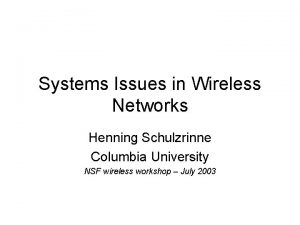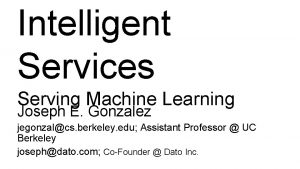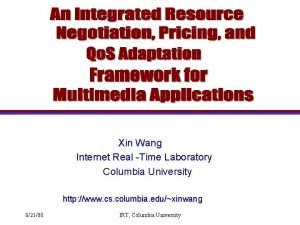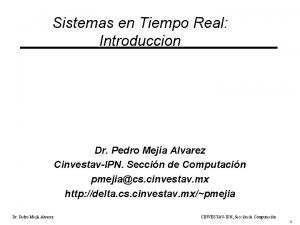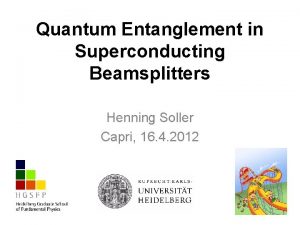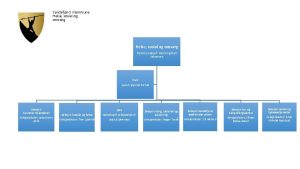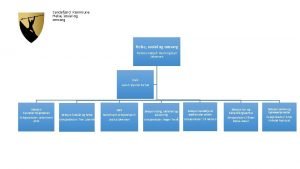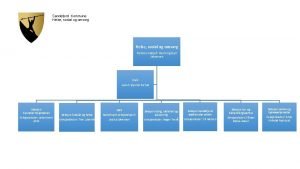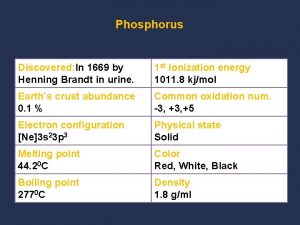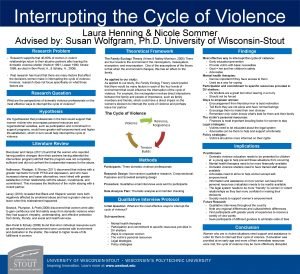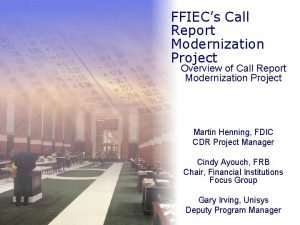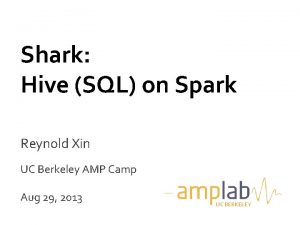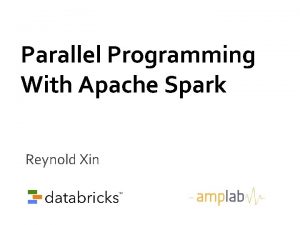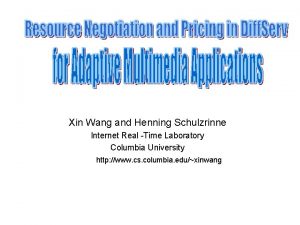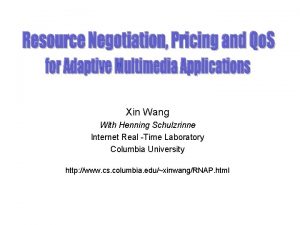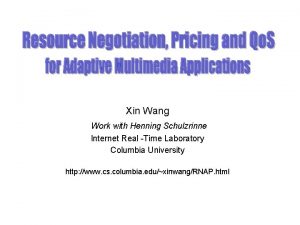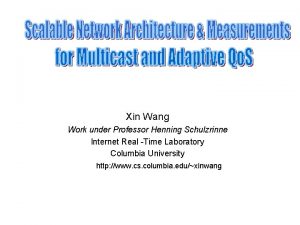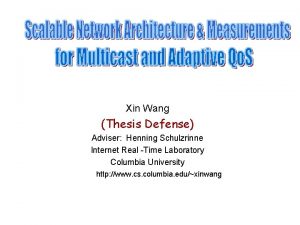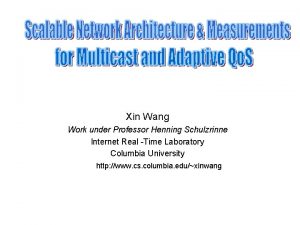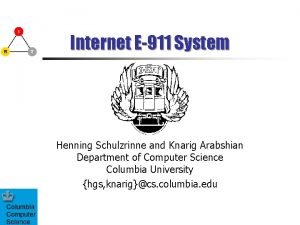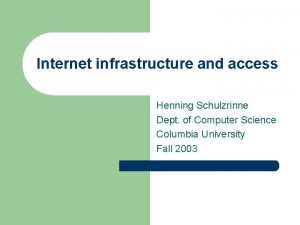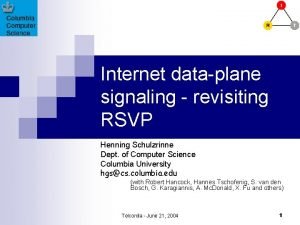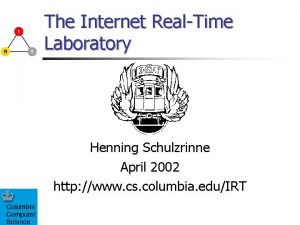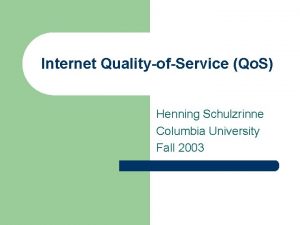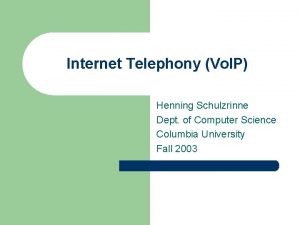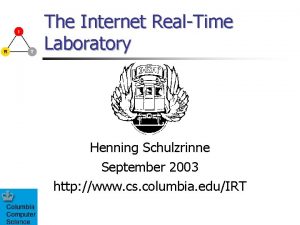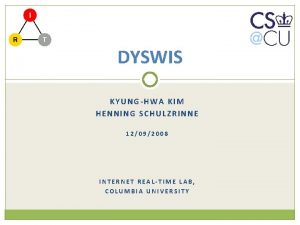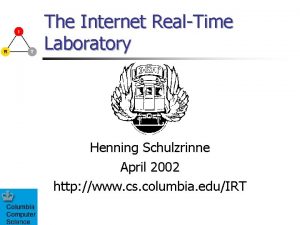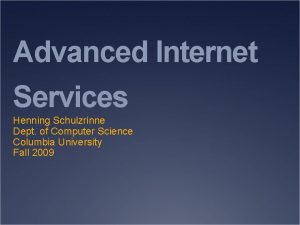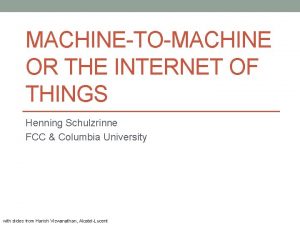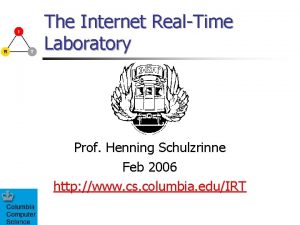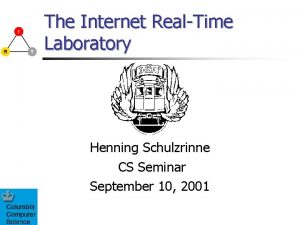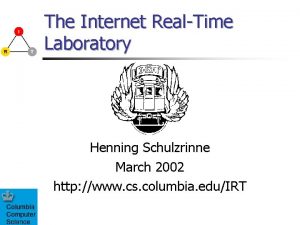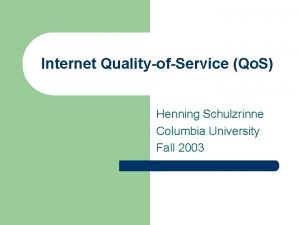Xin Wang and Henning Schulzrinne Internet Real Time



































- Slides: 35

Xin Wang and Henning Schulzrinne Internet Real -Time Laboratory Columbia University http: //www. cs. columbia. edu/~xinwang

Outline n n n Background RNAP: architecture and messaging Resource Negotiation Pricing models Framework User adaptation Testbed demonstration of Resource Negotiation Framework Simulation and discussion of Resource Negotiation Framework 12/17/2021 Xin Wang, Henning Schulzrinne, Columbia University 2

Is Simple Over-Provisioning Enough? n Current Internet: u u n Growth of new IP services and applications with different bandwidth and quality of service requirements Revenue from the traditional connectivity services is declining New services present opportunities and challenges u Even though average bandwidth utilization is low, congestion can happen; access links get congested frequently u Wireless bandwidth is even more scarce u Bandwidth prices are not dropping rapidly u No intrinsic upper limit on bandwidth use Option - manage the existing bandwidth better, with a service model which uses bandwidth efficiently. 12/17/2021 Xin Wang, Henning Schulzrinne, Columbia University 3

A More Efficient Service Model n Quality of Service (Qo. S) u Condition the network to provide predictability to an application even during high user demand u Provide multiple levels of services u How to manage multiple service more efficiently? How much to charge a service? n Application adaptation u Source rate adaptation based on network conditions congestion control and efficient bandwidth utilization u Best effort service u Why would an application adapt? 12/17/2021 Xin Wang, Henning Schulzrinne, Columbia University 4

A More Efficient Service Model (cont’d) n Requirements of Qo. S/adaptive model: u u u n n mechanism to select and negotiate services adaptive applications Allow dynamic resource short-term resource configuration for better negotiation during response to user demand network ongoing service conditions, for more efficient resource usage price network services based on Qo. S (resources consumed), allocate resources based on user willingness-to-pay provide signal / incentive for user adaptation through pricing A dynamic service selection and resource negotiation mechanism Usage-, Qo. S-, demand-sensitive pricing 12/17/2021 Xin Wang, Henning Schulzrinne, Columbia University 5

What We Add to Enable This Model n A dynamic resource negotiation protocol: RNAP u u u u n An abstract Resource Negotiation And Pricing protocol Enables user and network (or two network domains) to dynamically negotiate multiple services Enables network to formulate and communicate prices and charges Service predictability: commit service and price for an interval Multi-party negotiation: senders, receivers, or both Reliable and scalable Lightweight and flexible: embedded in other protocols, e. g. , RSVP, or implemented independently A demand-sensitive pricing model u u 12/17/2021 Enables differential charging for supporting multiple levels of services; services priced to reflect the cost and long-term user demand Allows for congestion pricing to motivate user adaptation Xin Wang, Henning Schulzrinne, Columbia University 6

What We Add. . . (cont’d) n n Demonstrate a complete resource negotiation framework (RNAP, pricing model, user adaptation) on test-bed network Show significant advantages relative to static resource allocation and fixed pricing using simulations: u Much lower service blocking rate under resource contention u Service assurances under large or bursty offered loads, without highly conservative provisioning u Higher perceived user benefit and higher network revenue 12/17/2021 Xin Wang, Henning Schulzrinne, Columbia University 7

Protocol Architectures: Centralized (RNAP-C) Host Resource Negotiator NRN HRN RNAP Messages NRN Network Resource Negotiator NRN HRN Access Domain - A Edge Router Access Domain - B Internal Router 12/17/2021 Transit Domain Intra-domain messages Xin Wang, Henning Schulzrinne, Columbia University 8

Protocol Architectures: Distributed (RNAP-D) RNAP Messages HRN LRN Local Resource Negotiator LRN LRN Access Domain - A LRN LRN LRN HRN LRN Edge Router Access Domain - B Internal Router 12/17/2021 LRN Transit Domain Xin Wang, Henning Schulzrinne, Columbia University 9

RNAP Messages Query: Inquires about available services, prices Periodic negotiation Query Quotation: Specifies service availability, accumulates service statistics, prices Commit Reserve: Requests services and resources, Modifies earlier requests Reserve Quotation Reserve specific price or denies it. Commit Close Release 12/17/2021 Commit: Confirms the service request at a Close: Tears down negotiation session Release: Releases the resources Xin Wang, Henning Schulzrinne, Columbia University 10

Message Aggregation (RNAP-D) Turn off router alert Turn on router alert Edge Routers Sink-tree-based aggregation 12/17/2021 Xin Wang, Henning Schulzrinne, Columbia University 11

Message Aggregation (RNAP-D) Turn on router alert Turn off router alert Sink-tree-based aggregation 12/17/2021 Xin Wang, Henning Schulzrinne, Columbia University 12

Message Aggregation (RNAP-C) NRN 12/17/2021 Sink-tree-based aggregation Xin Wang, Henning Schulzrinne, Columbia University 13

Block Negotiation (Network-Network) Bandwidth Aggregated resources are added/removed in large blocks to minimize negotiation overhead and reduce network dynamics time 12/17/2021 Xin Wang, Henning Schulzrinne, Columbia University 14

Two Volume-based Pricing Strategies n Fixed-Price (FP): fixed unit volume price u During congestion: higher blocking rate OR higher dropping rate and delay n Congestion-dependent-Price (CP): FP + congestionsensitive price component u During congestion: users have options to maintain service by paying more OR reducing sending rate OR switching to lower service class u Overall reduced rate of service blocking, packet dropping and delay 12/17/2021 Xin Wang, Henning Schulzrinne, Columbia University 15

Proposed Pricing Strategies n Holding price and charge: based on cost of blocking other users by holding bandwidth even without sending data u n Usage price and charge: maximize the provider’s profit, constrained by resource availability u u n phj = j (pu j - pu j-1) , chij (n) = ph j r ij (n) j max [Σl x j (pu 1 , pu 2 , …, pu. J ) puj - f(C)], s. t. r (x (pu 2 , …, pu. J )) R cuij (n) = pu j v ij (n) Congestion price and charge: drive demand to supply level (two mechanisms) 12/17/2021 Xin Wang, Henning Schulzrinne, Columbia University 16

Usage Price for Differentiated Service n Usage price based on cost of class bandwidth: u lower target load (higher Qo. S) -> higher per-unit bandwidth price n Parameters: u u u n n n pbasic rate for fully used bandwidth j : expected load ratio of class j xij : effective bandwidth consumption of application i Aj : constant elasticity demand parameter Price for class j: puj = pbasic / j Demand of class j: xj ( puj ) = Aj / puj Effective bandwidth consumption: xe j ( puj ) = Aj / ( puj j ) Network maximizes profit: u max [Σl (Aj / pu j ) pu j - f (C)], puj = pbasic / j , s. t. Σl Aj / ( pu j j ) C Hence: pbasic = Σl Aj / C , puj = Σl Aj /(C j) 12/17/2021 Xin Wang, Henning Schulzrinne, Columbia University 17

Congestion Price: First Mechanism Tatonnement n Tatonnement process (CPA-TAT): u Congestion charge proportional to excess demand relative to target utilization u pc j (n) = min [{pcj (n-1) + j (Dj, Sj) x (Dj-Sj)/Sj, 0 }+, pmaxj ] u ccij (n) = pc j v ij (n) 12/17/2021 Xin Wang, Henning Schulzrinne, Columbia University 18

Congestion Price: Second Mechanism M-bid Second-price Auction n Auction models in literature: u u u n Assume unique bandwidth/price preference, one bid Service uncertainty: user does not know about high demand until rejected Other issues: setup delay, signaling burst, user response to auction results M-bid auction Model u u u User bids (bandwidth, price) for a number of bandwidths, bids obtained by sampling utility function. Reduce uncertainty Network selects highest bids, charges highest rejected bid price During high demand: lower bandwidth (higher price per unit bandwidth) bids get selected; more users served Periodic auctions - support congestion control Inter-auction admission to reduce setup delay 12/17/2021 Xin Wang, Henning Schulzrinne, Columbia University 19

Example of M-bid Auction n Total capacity 70, congestion price is 2 Bid Bandwidth Bidder Bid Selection Bid Price 5 4 4 3. 5 3 2 10 10 15 20 25 1 2 1 3 2 30 3 Cutoff Congestion Price 12/17/2021 Xin Wang, Henning Schulzrinne, Columbia University 20

Rate Adaptation of Multimedia System n Utility/cost/bud n Gain optimal perceptual value of the system based on the network conditions and user profile Utility function: users’ preference or willingness to pay U 1 U 3 get 12/17/2021 U 2 Cost Budget Bandwidth Xin Wang, Henning Schulzrinne, Columbia University 21

Example Utility Function n Utility is a function of bandwidth at fixed Qo. S example utility function: U (x) = U 0 + log (x / xm) u U 0 : perceived (opportunity) value at minimum bandwidth u : sensitivity of the utility to bandwidth u An n Function of both bandwidth and Qo. S (x) = U 0 + log (x / xm) - kd d - kl l , for x xm u kd : sensitivity to delay u kl : sensitivity to loss u. U 12/17/2021 Xin Wang, Henning Schulzrinne, Columbia University 22

Two Rate-Adaptation Models n Model 1: User adaptation under CPA-TAT (tatonnementbased pricing) u u n Optimize perceived surplus of the multimedia system subject to budget and application requirements With the example utility functions, resource request of application i: è Without budget constraint: x i = i / pi è With budget constraint: x i = bi / pi, with b i = b ( i / Σl k ) Model 2: User adaptation under CPA-AUC (second-price auction) u Submit M-bid derived by sampling utility function; adapt rate based on allocated bandwidth/Qo. S 12/17/2021 Xin Wang, Henning Schulzrinne, Columbia University 23

Testbed Architecture RAT VIC n Mbus n HRN RN AP NRN n n 12/17/2021 Demonstrate functionality and performance improvement: u blocking rate, loss, delay, price stability, perceived media quality Host u HRN negotiates for a system u Host processes (HRN, VIC, RAT) communicate through Mbus Network u Router: Free. BSD 3. 4 + ALTQ 2. 2, CBQ extended for Diff. Serv u NRN: (1) Process RNAP messages; (2) Admission control, monitor statistics, compute price; (3) At edge, dynamically configure the conditioners and form charge Inter-entity signaling: RNAP Xin Wang, Henning Schulzrinne, Columbia University 24

Simulation Design n Performance comparison: u n n n Four groups of experiments: effect of traffic load, admission control, traffic burstiness, and load balance between classes Weighted Round Robin (WRR) scheduler Three classes: EF, AF, BE u u u n Fixed price policy (FP) (usage price + holding price) versus congestion price based adaptive service (CPA) (usage price + holding price + congestion price) EF: load threshold 40%, delay bound 2 ms, loss bound 10 -6 AF: load threshold 60%, delay bound 5 ms, loss bound 10 -4 BE: load threshold 90%, delay bound 100 ms, loss bound 10 -2 Sources: mix of on-off traffic and Pareto on-off traffic 12/17/2021 Xin Wang, Henning Schulzrinne, Columbia University 25

Simulation Architecture Topology 1 (60 users) 12/17/2021 Topology 2 (360 users) Xin Wang, Henning Schulzrinne, Columbia University 26

Effect of Traffic Load Average packet delay 12/17/2021 Average packet loss Xin Wang, Henning Schulzrinne, Columbia University 27

Effect of Admission Control Average packet delay 12/17/2021 Average packet loss Xin Wang, Henning Schulzrinne, Columbia University 28

Effect of Admission Control (cont’d) Average price and standard deviation 12/17/2021 Blocking rate Xin Wang, Henning Schulzrinne, Columbia University 29

Effect of Admission Control (cont’d) Network revenue 12/17/2021 Average user benefit Xin Wang, Henning Schulzrinne, Columbia University 30

Effect of Traffic Burstiness Average packet delay 12/17/2021 Average packet loss Xin Wang, Henning Schulzrinne, Columbia University 31

Load Balance Between Classes Average packet delay 12/17/2021 Average packet loss Xin Wang, Henning Schulzrinne, Columbia University 32

Simulation Results n n n Congestion-price-based policy (CPA) + user adaptation vs Fixed price policy (FP) + no adaptation: u limit congestion u lower request blocking rate, u higher user satisfaction u higher network revenue Differentiated service requires different target loads in each class Even without admission control, CPA policy restricts load to targeted level, can meet service assurance With admission control, blocking rate and price dynamics further reduced Allowing service class migration allows for service assurance at predicted level and further stabilizes price 12/17/2021 Xin Wang, Henning Schulzrinne, Columbia University 33

Conclusions n n n Proposed a dynamic resource negotiation framework: A Resource Negotiation And Pricing protocol (RNAP) , a rate and Qo. S adaptation model, and a pricing model RNAP: Supports dynamic service negotiation between network and users, and between peer networks Pricing models u u n Based on resources consumed by service class and long-term user demand, including congestion-sensitive component to motivate user demand adaptation during resource contention M-bid Auction Model serves more users than comparable auction schemes, and reduces uncertainty of service availability User adaptation: maximize perceived user satisfaction 12/17/2021 Xin Wang, Henning Schulzrinne, Columbia University 34

Further Work n n n Interaction of short-term resource negotiation with longerterm network provision A light-weight resource management protocol Cost distribution in Qo. S-enhanced multicast network Pricing and service negotiation in the presence of alternative data paths or competing networks User valuation models for different Qo. S Resource provisioning in wireless environment 12/17/2021 Xin Wang, Henning Schulzrinne, Columbia University 35
 Henning schulzrinne
Henning schulzrinne Xin wang uc berkeley
Xin wang uc berkeley Xin wang columbia law
Xin wang columbia law Sensor and (tiempo real or real time)
Sensor and (tiempo real or real time) Entanglement
Entanglement Carley nuzzo
Carley nuzzo Henning fjell johansen familie
Henning fjell johansen familie Kriminalgeschichte des christentums gesamtausgabe
Kriminalgeschichte des christentums gesamtausgabe Erich fromm haben oder sein
Erich fromm haben oder sein Henning fjell johansen
Henning fjell johansen Elise henning
Elise henning Matthias henning
Matthias henning Henning fjell johansen
Henning fjell johansen Henning kurz
Henning kurz Wade henning
Wade henning Henning hermjakob
Henning hermjakob Chemical properties of phosphorus
Chemical properties of phosphorus Laura henning
Laura henning Henning jørgensen aau
Henning jørgensen aau Jan henning pedersen
Jan henning pedersen Martin henning fdic
Martin henning fdic What is elapsed time
What is elapsed time Internet or internet
Internet or internet Sqlshark
Sqlshark Con xin dâng lên muôn lời suy tôn
Con xin dâng lên muôn lời suy tôn Xin dâng lời cảm tạ hồng ân thiên chúa bao la
Xin dâng lời cảm tạ hồng ân thiên chúa bao la Lạy cha xin tha cho họ
Lạy cha xin tha cho họ Một người ăn xin đã già
Một người ăn xin đã già Xin cao unsw
Xin cao unsw Lady dai xin zhui
Lady dai xin zhui Xin cho lòng chúng con
Xin cho lòng chúng con Lạy chúa chí ái tiếng con nài xin
Lạy chúa chí ái tiếng con nài xin Con xin tiến dâng rượu bánh nơi nương đồng
Con xin tiến dâng rượu bánh nơi nương đồng Reynold xin
Reynold xin Maranatha xin ngài hãy đến
Maranatha xin ngài hãy đến đông qua mau trúc xinh nghiêng nghiêng đợi chờ
đông qua mau trúc xinh nghiêng nghiêng đợi chờ
